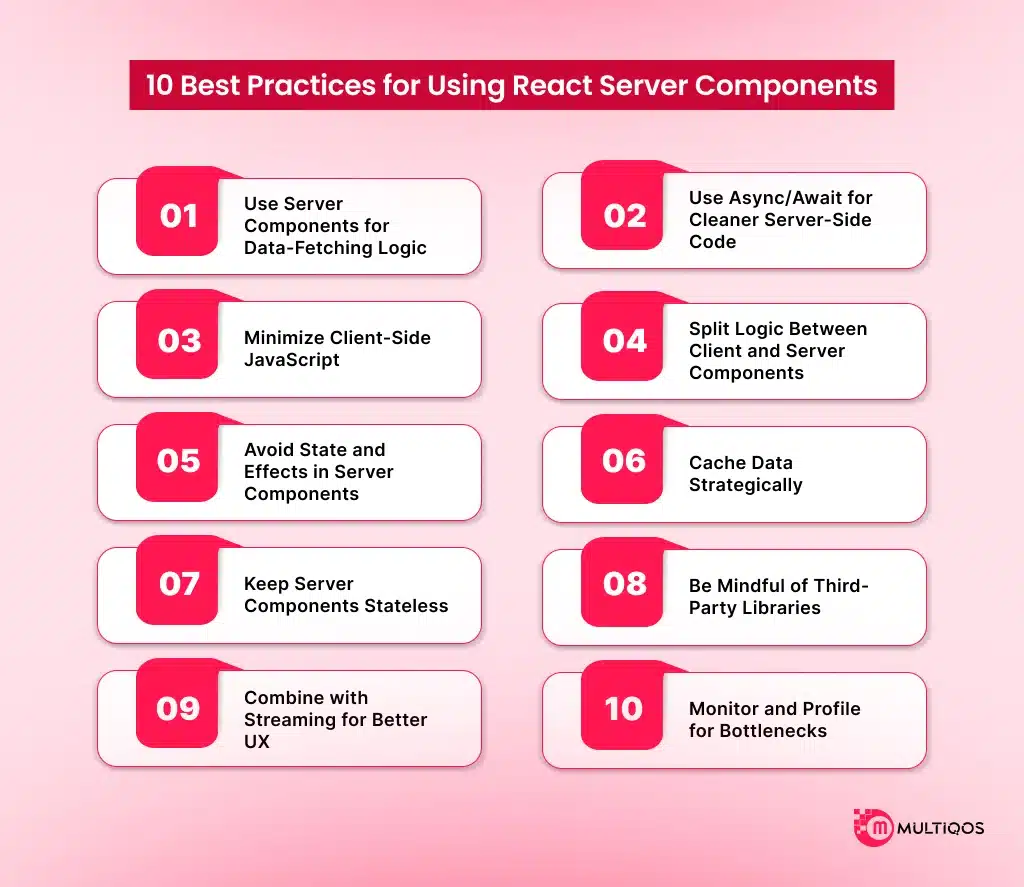Best Practices for Using React Server Components in Modern Web Development

Summary:
React Server Components are transforming how modern web applications are built by enabling server-side logic with minimal client-side overhead. In this guide, we explore the best practices for using React Server Components to build high-performance, scalable, and maintainable web applications.
You’ll learn when and how to use RSC effectively, how they differ from traditional client components, and how to optimize your codebase for speed and developer productivity. Whether you’re integrating RSC into an existing project or starting fresh, this article provides actionable insights and practical examples to help you stay ahead in modern React development.
Introduction
The development of easy, efficient, and fast user interfaces has become one of the foremost goals for developers. Like any tool, front-end frameworks transform to work with new methodological approaches as new demands for modern performance standards arise. With the vast new web app development solutions that have emerged in recent years, one of the most exciting new technologies is React Server Components. The purpose of this blog is to recommend ways of working with these components, particularly in application development processes, which enhance the scalability and performance of the application.
What are React Server Components?
React Server Components, or RSC, enable the server to handle all operations related to a component rendering and bypass the browser completely. Traditional client components render in the browser and both fetch data and generate HTML, adding to the JavaScript bundle on the client side. This transforms the architecture to be faster with reduced bundle size and clutter. Portions of a UI that are static or heavily populated with data, RSC will handle rendering automatically, as browser APIs and interactivity are not relied on.
When it comes to web development, using React Server Components can greatly enhance performance and scalability. They allow rendering that requires a lot of logic to be moved from the client side. This is beneficial for large applications since speed and efficiency are important. By thoughtfully integrating Server and Client Components, Teamwork improves the responsiveness of applications and maintains modern user expectations.
Why React Server Components Matter in Modern Web App Development?
For optimizing the performance and scalability of modern web applications, React Server Components really do the trick. They decrease the content that needs to be rendered on the client side by offloading it to the server. This results in a smaller amount of JavaScript sent to the browser, furthering the acceleration of the page load speed while enhancing user experience. Developers do not have to deal with client-side interactivity issues while dealing with the logic on the server side.
Here are some key advantages of React Server Components:
- Enhanced Performance: The reduction of JavaScript on the client side results in better load time.
- Smaller Bundles: When it comes to server-side, it efficiently fetches and renders the data, which keeps client bundles relatively small.
- Heightened Scalability: Increased server-side performance with app data fetching and rendering improves the performance of your app.
- Enhanced Developer Experience: Overall developer experience is also enhanced with the simplification of the development flow that stems from separable server and client responsibilities.
- Streamlined End User Experience: Regardless of the device, the application executes its functions effortlessly even on low bandwidth networks.
10 Best Practices for Using React Server Components
1. Use Server Components for Data-Fetching Logic
One of React Server Component’s abilities is to run completely on a server is arguably its biggest advantage. This makes them exceptionally useful for data fetching tasks like database queries, API requests, and reading files from the file system. Performing data handling on a server avoids client exposure to sensitive logic. Additionally, it minimizes client-side state management and excessive API requests.
2. Use Async/Await for Cleaner Server-Side Code
Using async/await, server components in React can fetch and render data asynchronously. That gives the luxury of writing promise-based logic inside the components, and as simple as a child’s play. For instance, taking user data from the database can happen inside the component itself, which alleviates the need for useEffect or any loading states to show in the framework.
export default async function ProductList() {
const products = await fetchProductsFromDB();
return <ul>{products.map(p => <li key={p.id}>{p.name}</li>)}</ul>;
}
3. Minimize Client-Side JavaScript
Reducing the amount of JavaScript sent to the browser is always a win, performance-wise, and React Server Components do just that. If more rendering responsibility is shifted towards the server, the bundle size can be drastically reduced. This benefits users on mobile or those with slower networks. Always ask yourself: Does this component really need to run on the client? If not, turn it into a Server Component.
4. Split Logic Between Client and Server Components
Focus on the separation of concerns. Server Components manage rendering alongside data logic, while Client Components manage user interactions, browser interfaces, client-side hooks, and any other client-specific operations. Keeping these boundaries aids in effective maintenance and improves optimization for rendering within React.
5. Avoid State and Effects in Server Components
Server Components are static and do not retain state information between renders. Refrain from using any hooks such as useState, useEffect, useReducer, or any hooks that pertain to React’s lifecycle. Rather, every piece of data should be calculated before the rendering phase and given to interactive Client Components as props.
6. Cache Data Strategically
Although React server components have the ability to retrieve fresh data, not every request must be real-time. Improve performance and lessen workload on the server with caching methods like Next.js’s fetching caching with revalidate options, or even in-memory caches. Find the balance between what is needed in real-time and what is best for the user.
7. Keep Server Components Stateless
Considering that every Server Component render is isolated and based on request, do not depend on shared mutable state or server-side sessions without context providers or APIs managing them. Instead, append all needed data as props and ensure the logic remains clean and reliable.
8. Be Mindful of Third-Party Libraries
Some libraries are not safe for the server. Any package that relies on browser APIs, such as window, document, or localStorage, will fail in a Server Component. Always verify compatibility, or use dynamic imports to load client-only code conditionally within Client Components.
9. Combine with Streaming for Better UX
The capability for server streaming, where parts of the UI can be rendered and sent to the client as they are ready, has been added in React 18. When paired with streaming systems such as Next.js App Router, React server components offer improved “first paint” times even during backend fetch delays.
10. Monitor and Profile for Bottlenecks
Avoid thinking that shifting logic to the server side will fix all performance challenges. Utilize profiling tools such as Chrome DevTools, React DevTools, and APM (Application Performance Monitoring) tools to evaluate render times, locate suboptimal database queries, and find potential improvement opportunities.
Wrapping Up
React Server Components have the ability to optimize rendering, fortify performance, and ease the building of scalable web applications simultaneously. By adhering to the best practices provided above, like concern separation, optimized data fetching, and caching, you can make the most out of this modern architecture. If you are looking to enhance your current app or if you are looking at starting a new project, partnering with an experienced ReactJS development company will add an advantage to your application by incorporating the server components, which would enable you to stay on par with the changing trends of the development world.
Frequently Asked Questions
React Server Components (RSC) allow components to operate fully on the server. Their advantages include data fetching and rendering logic happening server-side, which minimizes client bundle size and enhances application speed. RSCs function in harmony with Client Components in contemporary frameworks such as Next.js.
Use Server Components for the rest of the UI that does not require interaction, especially when they involve data fetching or processing, and rendering, which do not need JavaScript on the browser side. In case there is a need for interactivity, stateful information, or browser APIs, then Client Components should be used.
When you hire React.js developers for your project, ensure that particular components like hooks and state mechanisms are well within the individual’s grasp. Knowledge of more sophisticated items like React Server Components and accompanying frameworks like Next.js is just as critical. Effective optimizers of performance with troubleshooting prowess are so aptly skilled and experienced that they may be added to the team without a second thought.
Indeed, RSCs enhance performance by minimizing the amount of JavaScript offloaded to the client, enabling server-side computation of data. As a result, the initial loads are quicker and the experience is smoother when using low-powered devices or on slow networks.
Not yet. RSCs are best supported by frameworks like Next.js (App Router), which utilize modern React features like server rendering and streaming. Support for RSCs may require additional configuration for Vanilla React apps.
Get In Touch







